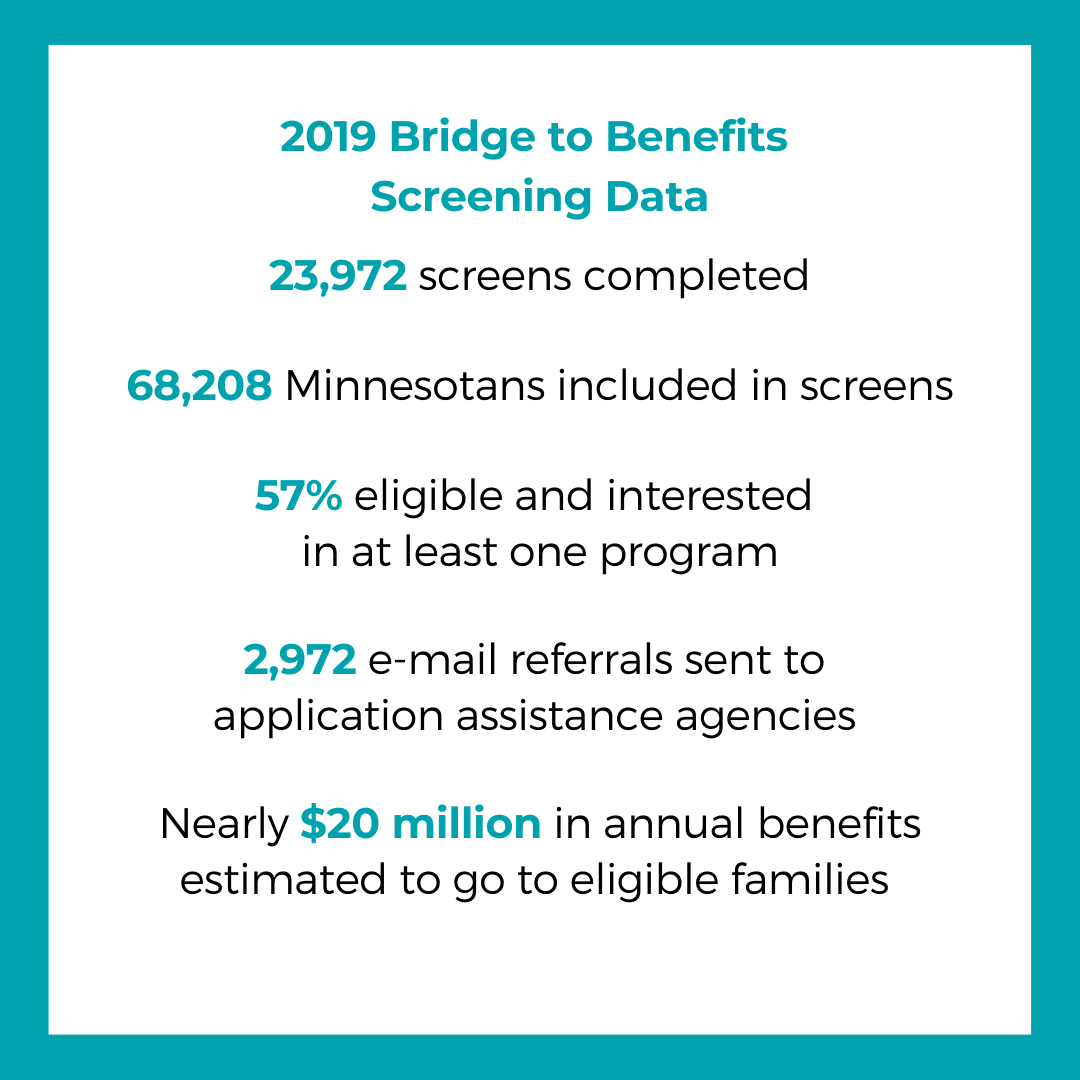
Bridge to Benefits is an initiative by Children’s Defense Fund-Minnesota to increase awareness and participation in public work support programs and federal and state tax credits to improve family economic stability and, in turn, improve child outcomes. The web-based project relies on an online screening tool that helps determine potential eligibility for an array of programs. Work support programs and tax credits were implemented by federal and state governments to help low-income workers meet basic needs. Yet, in Minnesota, thousands of eligible families are not participating in these programs or claiming the tax credits that could provide increased economic stability for their families.
The goals of Bridge to Benefits are to:
- Increase awareness and participation in public work support programs and tax credits;
- Improve economic stability and well-being of low-income families by connecting them to work support programs that help meet basic needs;
- Promote healthy child development;
- Help families navigate complicated public program enrollment processes;
- Assist service providers by forming a “network of support” to ensure families receive the help they need;
- Strengthen communities by bringing in more federal and state dollars through the increased number of families who are participating in public programs and tax credits.
As Minnesotans confront health and financial hardships as a result of COVID-19, Bridge to Benefits will help families find support. On the B2B website, you’ll find information on health, nutrition, and financial resources. As the situation evolves, the information will be updated daily.
What programs are included in Bridge to Benefits?
Although there are many different types of public programs, Bridge to Benefits focuses on the programs that benefit low-income, working Minnesota families. These include Medical Assistance, MinnesotaCare, the Advanced Premium Tax Credits, Child Care Assistance, Early Learning Scholarships, Energy Assistance, Supplemental Nutrition Assistance Program (SNAP), School Meal Program, Women, Infants, and Children (WIC) Program, Earned Income Tax Credit (EITC) and Working Family Credit (WFC).
Why focus on public work support programs and tax credits?
Living in poverty has devastating effects on a child’s development. Research confirms, however, that even small increases in a family’s income – as little as $370 a month – can have positive impacts on children’s cognitive, social and behavioral development outcomes. Participating in public programs puts money in the pockets of low-income families, benefiting their economic, social, and physical health.
How does Bridge to Benefits work?
The Bridge to Benefits project basically consists of two steps– 1) screening low-income families for potential eligibility in Minnesota’s work support and tax credit programs and 2) helping families complete the application process for the programs for which they appear eligible.
Step One, Screening: Bridge to Benefits relies on an online screening tool (www.bridgetobenefits.org). By completing the screening process, which takes about 5 to 10 minutes, a family can find out if they are potentially eligible for all these programs and two tax credits. The site also provides descriptions of each program, tips on how to apply, a list of verifications required for each program, downloadable applications and information on where to apply for each program. The site will also lead families to any organizations within their counties that provide one-on-one application assistance for the programs. The site is quick and simple to use and although it is available to any family to use on their own, CDF Minnesota believes the website is most effective when used as part of a community-wide program to support working families. Thus, CDF Minnesota looks to recruit community organizations that serve a large number of working families and are willing to integrate the Bridge to Benefits screening into their everyday work. The screening tool enhances the ability to provide resources to families in a one-stop approach. Potential screening organizations may be schools, job placement centers, social service agencies, housing organizations, family resource centers, food shelves, WIC sites, Head Start programs, etc. There are currently about 300 organizations across Minnesota that use the screening tool on a regular basis.
Step Two, Application Assistance: CDF-MN also seeks to identify local organizations that can help families complete the enrollment process for one or more of the public programs to ensure families get enrolled if they are eligible. These “application assistance” organizations or “navigators” provide families with one-on-one assistance (such as completing a program application) that may be required to overcome the many obstacles that prevent families from participating in public programs. Examples of this type of organization may be a Community Action Agency that provides assistance in applying for energy assistance, a food shelf that helps families apply for food support, or a health care organization that helps families apply for Medical Assistance. CDF Minnesota has already identified an array of statewide partners that will provide this type of assistance. A family that is screened at one of the screening organizations will be directly referred to one or more of the application assistance organizations in their counties to help them complete application processes. A direct referral means that a family’s contact information is forwarded – via the Bridge to Benefits website – to the application assistance organizations, who agree to follow up with that family about starting the enrollment process. This relieves the family of the burden of contacting multiple organizations in order to receive help in applying to programs. This electronic screening and direct referral process is what elevates the Bridge to Benefits project beyond a typical resource and referral project.
How do organizations become involved in Bridge to Benefits?
If your organization currently assists low-income families in finding resources or improving their economic stability, Bridge to Benefits may help meet your goals. If your organization currently assists families in completing applications for a public program, CDF Minnesota would be interested in talking to you about becoming a Bridge to Benefits partner. Learn more about how to become a partner.

